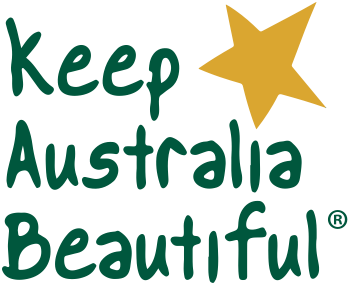CONTAIN YOUR WASTE IS ALL ABOUT WASTE REDUCTION
Whilst it’s important to recycle and reuse, reducing waste at the source is the most effective and efficient way to make a genuine impact in Australia, to decrease the amount of litter we find in our streets and public areas.
So for 1 week, we challenge you to choose an existing container from around the house – a jar, a tub, or a bucket and contain the amount of waste you produce that week to the capacity of your container.
You can try this challenge ANY TIME during the year, it doesn’t have to be in NOVEMBER, but we still want to hear from you and see how you went, so don’t forget to tag us @keepaustraliabeautiful #ContainYourWaste.
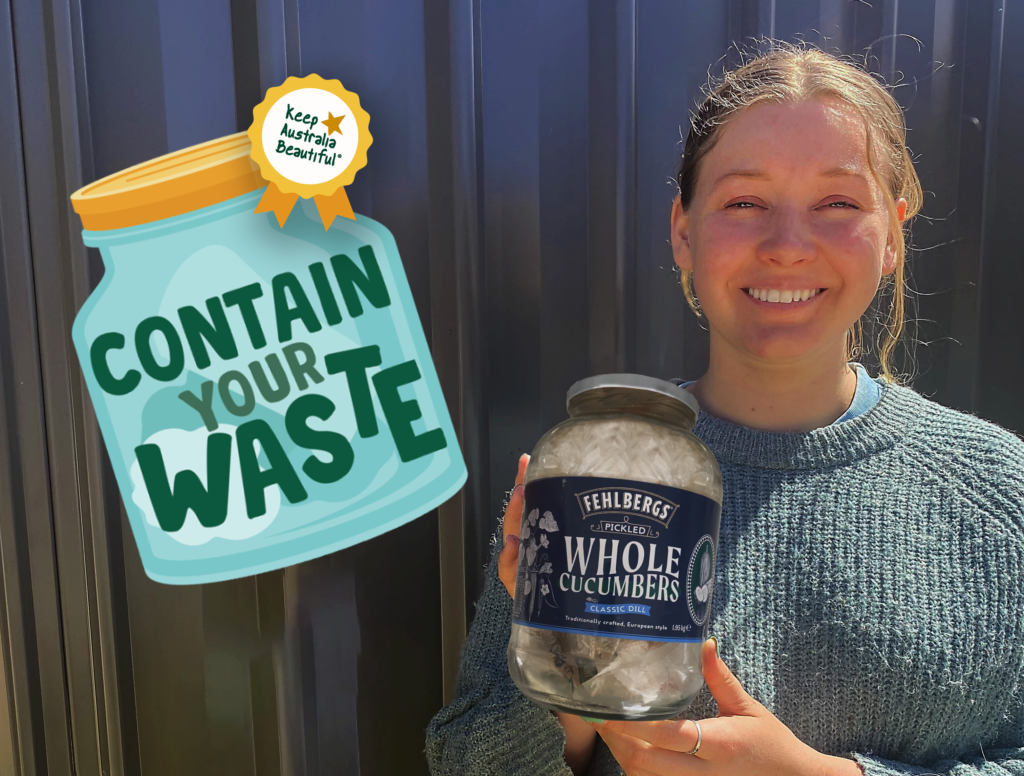
Rosie Starr, KAB Content Creator and Volunteer, showing us her successful Contain Your Waste Challenge.
What is it?
Contain Your Waste is a former KAB Week campaign that proved so successful we now challenge ourselves every year! Each November we challenge you to rethink your waste habits.
The goal is to rethink, reduce, and contain all the waste you produce to fit inside a container of your choice. Challenge yourself to use reusables, avoid single-use plastics, and get creative about minimising waste at home and on the go.
Think about each item you throw out—can you recycle, compost, or repurpose it? Every small effort makes a big difference, helping to keep waste out of landfills and reduce our environmental footprint.
There are also creative ways to reuse soft plastics like zip-lock bags, bread bags, and postage bags. Instead of tossing them, consider giving these items a second life—use them for storage, as liners, or for DIY projects. By reusing soft plastics, we keep them out of landfill a little longer and reduce the need for new plastic bags.
Try setting aside a space to store soft plastics you can reuse and challenge yourself to get creative! It’s all about finding ways to reduce waste and embrace sustainable habits, one small step at a time.

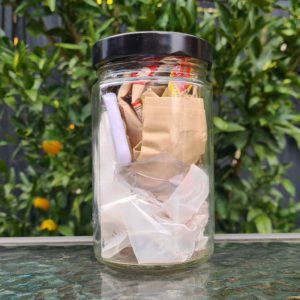
What’s involved?
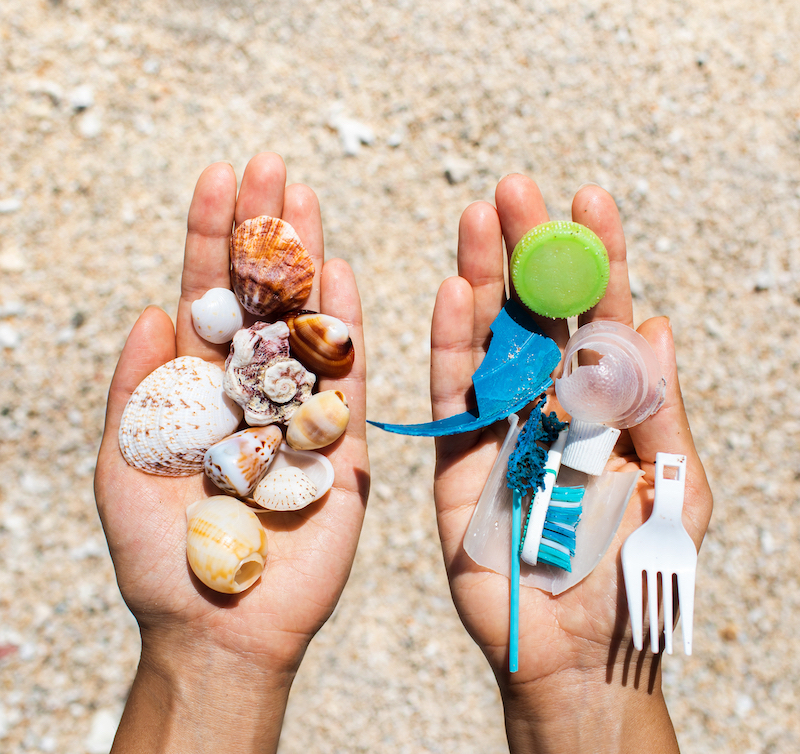
Why do it?
Australians Falling Short on Recycling Targets
In Australia, we’re lucky to call one of the most beautiful environments in the world our home. Unfortunately though, we have very poor waste and recycling habits which jeopardise our wildlife, natural environment and the quality of life for future generations.
Of the 1.1M tonnes of Australian plastic packaging reportedly placed on the market, only 16% (179,000 tonnes) was recovered via recycling in 2021.* Australia is likely to miss our 2025 target to recycle or compost 70% of plastic packaging. The latest report from the Australian Packaging Covenant Organisation (APCO) estimates that only 36% of plastic packaging will end up in recycling or compost by 2025*.
APCO also indicates that Australians are only recycling 4% of soft plastics used for food packaging. The rest is ending up in land fill, or finding its way into our oceans.*
Other items made from recyclable packaging are also making their way into landfill rather than being recycled properly, due to incorrect disposal by consumers and businesses. Only 68% of paper/cardboard, 60% of glass, 37% of wood and 56% of metal were reported as recycled in 2021 by APCO*.

What is it?
Contain Your Waste is a former KAB Week campaign that proved so successful we now challenge ourselves every year! Each November we challenge you to rethink your waste habits.
The goal is to rethink, reduce, and contain all the waste you produce to fit inside a container of your choice. Challenge yourself to use reusables, avoid single-use plastics, and get creative about minimising waste at home and on the go.
Think about each item you throw out—can you recycle, compost, or repurpose it? Every small effort makes a big difference, helping to keep waste out of landfills and reduce our environmental footprint.
There are also creative ways to reuse soft plastics like zip-lock bags, bread bags, and postage bags. Instead of tossing them, consider giving these items a second life—use them for storage, as liners, or for DIY projects. By reusing soft plastics, we keep them out of landfill a little longer and reduce the need for new plastic bags.
Try setting aside a space to store soft plastics you can reuse and challenge yourself to get creative! It’s all about finding ways to reduce waste and embrace sustainable habits, one small step at a time.


What’s involved?

Why do it?
Australians Falling Short on Recycling Targets
In Australia, we’re lucky to call one of the most beautiful environments in the world our home. Unfortunately though, we have very poor waste and recycling habits which jeopardise our wildlife, natural environment and the quality of life for future generations.
Of the 1.1M tonnes of Australian plastic packaging reportedly placed on the market, only 16% (179,000 tonnes) was recovered via recycling in 2021.* Australia is likely to miss our 2025 target to recycle or compost 70% of plastic packaging. The latest report from the Australian Packaging Covenant Organisation (APCO) estimates that only 36% of plastic packaging will end up in recycling or compost by 2025*.
APCO also indicates that Australians are only recycling 4% of soft plastics used for food packaging. The rest is ending up in land fill, or finding its way into our oceans.*
Other items made from recyclable packaging are also making their way into landfill rather than being recycled properly, due to incorrect disposal by consumers and businesses. Only 68% of paper/cardboard, 60% of glass, 37% of wood and 56% of metal were reported as recycled in 2021 by APCO*.

REGISTER FOR 2025
Tips on how to Contain Your Waste
Tips on how to
Contain Your Waste
Contain Your Waste
Need inspiration on how to contain your waste in one jar?
Here are some stories from some incredible people who share their experience:
Laura explains how she tackled her Contain Your Waste challenges
See our Brand Manager, Laura Carrazza, explain the Contain Your Waste Challenge she did in 2022 (note that RedCyle was available at the time this video was filmed in August 2022 – so your soft plastics will now go in your container!)

Keep Australia Beautiful’s Brand & Marketing Manager, Laura Carrazza, talks about the importance of reducing land-fill through waste-free purchases, sustainable packaging, recycling, composting and general household waste reduction.
Laura Summarises how her family went with the Contain Your Waste challenge…
TIPS: When hosting at your house during the Contain Your Waste challenge, consider what your guests will bring and plan meals & snacks that are in recyclable or compostable packaging… (Note in 2022 when this challenge was completed, RedCyle was available – so your soft plastics will now go in your container!)
Need inspiration on how to contain your waste in one jar?
Here are some stories from some incredible people who share their experience:
Laura explains how she tackled her Contain Your Waste challenges
See our Brand Manager, Laura Carrazza, explain the Contain Your Waste Challenge she did in 2022 (Note that RedCyle was available at the time this video was filmed in August 2022 – so your soft plastics will now go in your container!)

Keep Australia Beautiful’s Brand & Marketing Manager, Laura Carrazza, talks about the importance of reducing land-fill through waste-free purchases, sustainable packaging, recycling, composting and general household waste reduction.
